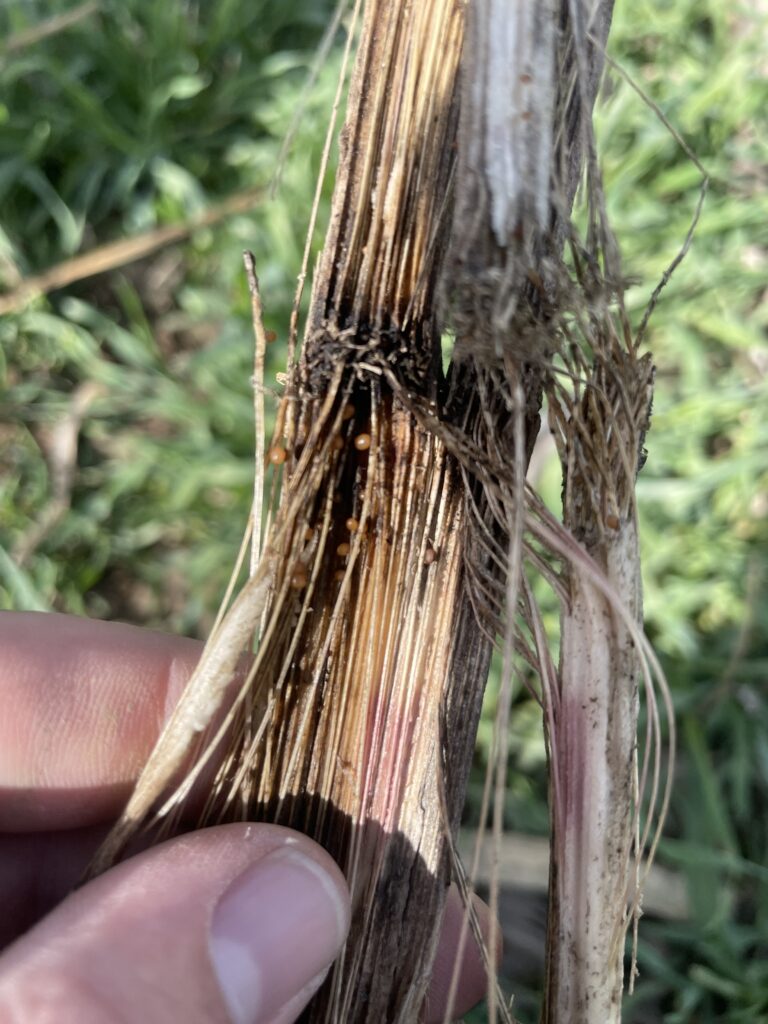A few weeks ago, I received the following picture and was asked what are those small, brown things that were hiding in some corn stubble left in the field.

Dr. Nick Seiter, University of Illinois Extension Entomologist, came to my rescue and said the following, “I’ve seen these in corn stubble before. There are several things that it could be, but I think it might be earthworm egg cocoons. The reality of course is that a lot of eggs look similar, so it could be something different – it does not resemble any of the pest eggs I’m familiar with though.”
When we find earthworms in fields, we often think there is healthy soil; however, the importance of earthworms in different ag systems is not fully understood. Be careful not to judge soil by its number of earthworms because some soil can still be productive even if earthworms are not present. We do know that worms have been shown to have direct impact on improving crop growth and yield, as well as an indirect impact by positively affecting soil tilth and drainage.
There can be thousands of earthworm species found throughout the world and they can be grouped into litter-dwellers, shallow dwellers, and deep-burrowers. We usually find several shallow dwelling species and a few deep burrowing species (nightcrawlers) in an agriculture field.
Nightcrawlers can be absent if there is no residue left on the surface because they need it to pull down into their burrows. The litter dwellers don’t build permanent burrows, so they are not sensitive to residue management; however, they are affected by the amount of surface mulch because it can have an impact on soil temperature and moisture extremes. The best time to evaluate earthworm populations is early to mid-spring (now) or late fall.
One thing I remember from my first dissection in my high school biology class is that earthworms have both male and female parts. But most species do need to find a mate to acquire sperm so that it can be stored to later produce a cocoon casing or the band often seen on mature worms. The worm backs out of the band (cocoon case) and then drops off the sperm and eggs over it. This cocoon, as seen in the above picture, is 2 to 4 mm in diameter and incubates for several months. When the soil conditions and the temperature are right, one or two new worms emerge.
Check out https://youtu.be/G_aav9IXVWk for a full basic lifecycle of a typical earthworm.
How can we get more earthworms in our fields?
Earthworm populations can be heavily influenced by management systems that encourage surface residue because it provides food and protection. In turn, it can allow for a longer time for worms to feed and reproduce in the spring. It also provides a longer period for them to get used to the summer or winter and to move further down to their resting state. The addition of winter cover crops and manure (if there is not a high concentration of ammonia in the slurry) can also help to build up earthworms in the field.
If you make the switch to a no-till system, it could be a slow process to encourage earthworm populations and you will need to have a source of nightcrawlers move from nearby fencerows, roadsides, or grass waterways to the field. Unfortunately, there also may be some soil types (heavy clay), soil pHs, soil texture (sand), or soil drainage properties that may not support high earthworm populations regardless of your management practices. Other factors can also affect earthworm populations such as summer drought conditions. The most important thing to remember is that earthworms prefer legumes or soybeans for food, and this could be why you find more of them in soybean fields.
Reference: AY-279: Earthworms and Crop Management (purdue.edu)






 and then
and then